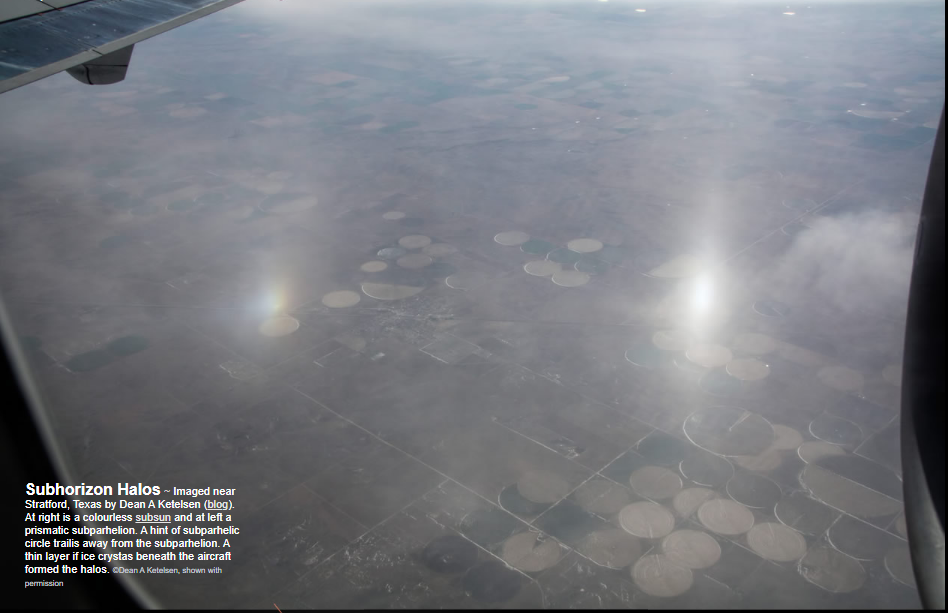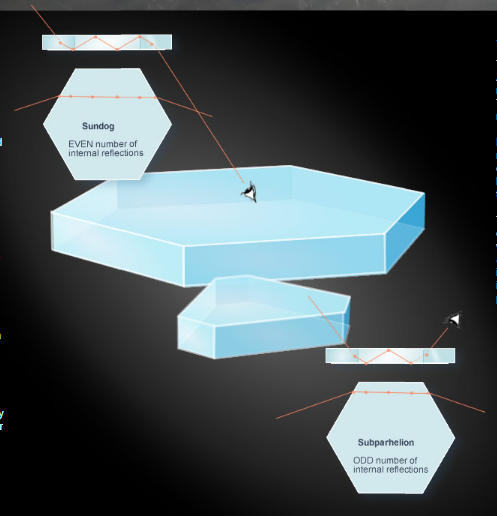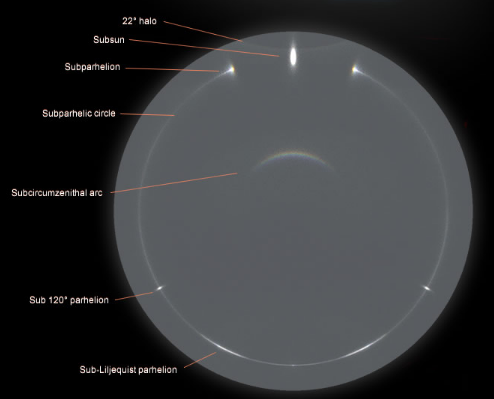Subhorizon halos - OPOD
Subhorizon Halos: A Fascinating Atmospheric Phenomenon
Subhorizon halos are captivating optical phenomena that occur in the Earth's atmosphere. These ethereal displays of light are often overlooked but hold a unique beauty that is worth exploring. In this article, we will delve into the intricacies of subhorizon halos, shedding light on their formation, characteristics, and the mesmerizing effects they create in the sky.
Odd or Even? The Formation of Sundogs and Subparhelions
The classification of a sun ray as a sundog or subparhelion depends on the count of internal reflections it undergoes within an ice crystal. Sundogs, also known as 22 degree parhelia, are typically formed when rays enter a side face of a horizontal plate ice crystal in cirrus clouds and exit through a second side face inclined at 60 degrees to the first. However, the reality is not always as straightforward as it seems.
In most cases, when a sun ray enters the ice crystal, it intercepts the lower crystal face and undergoes internal reflection. This internal reflection can occur multiple times between the upper and lower large faces before eventually exiting through a side face. If there is an even number of internal reflections, a sundog is formed above the horizon. Conversely, an odd number of reflections results in the creation of a subparhelion.
Subhorizon Halos: Independent Light Displays
Subhorizon halos, much like their above-horizon counterparts, are produced when each sun ray interacts with a crystal only once. They are not halos created from the light of other halos. These halos are formed by the interaction between sunlight and plate crystals present in the atmosphere. The thin layer of ice crystals beneath an aircraft can often serve as the canvas for the formation of these captivating subhorizon halos.
The Enigmatic Subsuns
One of the mesmerizing features associated with subhorizon halos is the presence of subsuns. Subsuns can be blindingly bright, resembling the reflection of the sun on a mirror-like surface. In reality, there are millions of mirror-like reflections happening simultaneously. The subsun is usually vertically elongated due to the wobbling motion of the drifting plate crystals within the cloud air currents. As the wobbling increases, the subsun transforms into a lower sun pillar, while the ray paths remain the same.
Exploring the Array of Subhorizon Halos
Subhorizon halos exhibit a wide variety of forms, each with its own distinct characteristics. Through the use of advanced computer ray tracing simulations, scientists have been able to visualize the potential subhorizon halos that could result from a layer of plate crystals beneath an observer. Some of these observed subhorizon halos include:
- Subparhelic circle
- Sub 120° parhelion
- Sub-Liljequist parhelia
- Sub CZA - circumnadiral arc
These breathtaking displays of light add to the awe-inspiring nature of subhorizon halos, showcasing the remarkable complexity of atmospheric optics.
Conclusion: A Glimpse into the Subtle Beauty of Subhorizon Halos
Subhorizon halos are a captivating phenomenon that often goes unnoticed in the vast expanse of the sky. Understanding their formation and characteristics provides us with a deeper appreciation for the intricate interplay between sunlight and ice crystals in our atmosphere. The subtle beauty and enigmatic nature of subhorizon halos serve as a reminder of the boundless wonders that exist above us. So, next time you find yourself gazing at the sky, take a moment to look beyond the obvious and discover the hidden marvels that lie within subhorizon halos.

Subhorizon Halos ~ Imaged near Stratford, Texas by Dean A Ketelsen (blog). At right is a colourless subsun and at left a prismatic subparhelion. A hint of subparhelic circle trailis away from the subparhelion. A thin layer if ice crystas beneath the aircraft formed the halos. ©Dean A Ketelsen, shown with permission

Odd or Even?
Whether a sun ray forms a sundog or subparhelion depends on a count of internal reflections.
Sundogs or 22 degree parhelia are said to arise from rays entering a side face of a horizontal plate ice crystal in cirrus cloud and leaving through a second side face inclined 60 degrees to the first. That is, like the curate's egg, true in parts. Unless the sun is low on the horizon or the plate is unusually thick events are not quite that straightforward.
Instead, once inside the ice, most rays intercept the lower crystal face and internally reflect. They can reflect up and down between the upper and lower large faces several times before eventually leaving through a side face.
An even number of internal reflection gives a sundog above the horizon. An odd number produces a subparhelion.
Subhorizon halos are, like their above horizon counterparts, produced by each sun ray interacting only once with a crystal. They are not halos produced from the light of other halos.
Subsuns
They can be blindingly bright. Almost as though the sun is reflected by a mirror-like lake. There is not one mirror but millions.
Plate crystals are again responsible and sunlight reflects either externally from their top hexagonal faces or internally from the lower one.
The subsun is usually vertically elongated because the plates are wobbling as they drift in the cloud air currents. As the wobble increases the subsun transforms into a lower sun pillar. The ray paths are the same.

A HaloSim computer ray tracing looking straight downwards. It shows subhorizon halos that might result from a layer of plate crystals beneath you. All have been observed:
subparhelic circle
sub 120° parhelion
sub-Liljequist parhelia
sub CZA - circumnadiral arc
Note: this article has been automatically converted from the old site and may not appear as intended. You can find the original article here.
Reference Atmospheric Optics
If you use any of the definitions, information, or data presented on Atmospheric Optics, please copy the link or reference below to properly credit us as the reference source. Thank you!
-
<a href="https://atoptics.co.uk/blog/subhorizon-halos-opod-2/">Subhorizon halos - OPOD</a>
-
"Subhorizon halos - OPOD". Atmospheric Optics. Accessed on May 2, 2024. https://atoptics.co.uk/blog/subhorizon-halos-opod-2/.
-
"Subhorizon halos - OPOD". Atmospheric Optics, https://atoptics.co.uk/blog/subhorizon-halos-opod-2/. Accessed 2 May, 2024
-
Subhorizon halos - OPOD. Atmospheric Optics. Retrieved from https://atoptics.co.uk/blog/subhorizon-halos-opod-2/.